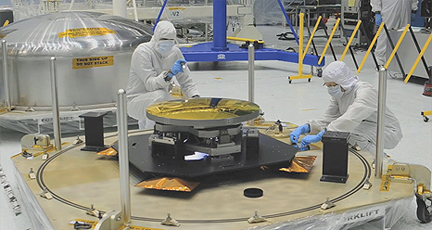
Two Webb Mirror Segments Arrive at NASA—The sole secondary mirror and a third primary mirror segment that will fly aboard the Webb telescope are now in a NASA clean room.
Photo courtesy of NASA
...NASA's James Webb Space Telescope have arrived at NASA's Goddard Space Flight Center in Greenbelt, Maryland from Ball Aerospace & Technologies Corp. of Boulder, Colorado. Ball Aerospace manufactured the mirrors, packed and shipped them to NASA.
Unlike the 18 hexagonal primary mirror segments that make up the biggest mirror on the Webb telescope, the secondary mirror is perfectly rounded. The mirror is also convex, so the reflective surface bulges toward a light source. It looks much like a curved mirror that you'll see on the wall near the exit of a parking garage that lets motorists see around a corner. The quality of the secondary mirror surface is so good that the final convex surface at cold temperatures does not deviate from the design by more than a few millionths of a millimeter—or about one ten thousandth the diameter of a human hair.
The powerful primary mirrors of the James Webb Space Telescope will be able to detect the light from the first luminous objects that formed when the universe was young, as well as distant galaxies and nearby stars and their planets. Altogether, 21 mirrors comprise the Webb's telescope optics—18 primary mirror segments working together as one large 21.3-foot (6.5-meter) primary mirror, the secondary mirror mounted on a tripod above the primary mirror, and the tertiary mirror and the fine steering mirror that are both located inside an assembly near the center of the primary mirror.
All of the mirrors are made of beryllium, which was selected for its stiffness, light weight and stability at cryogenic temperatures. Bare beryllium is not very reflective of near-infrared light, so each mirror is coated with gold. The microscopic gold coating enables the mirrors to efficiently reflect infrared light (which is what the Webb telescope's cameras see).
On Sept. 17, 2012, two other primary mirror segments arrived at NASA Goddard and are currently being stored in the giant clean room. The most powerful space telescope ever built, the Webb telescope will provide images of the first galaxies ever formed, and explore planets around distant stars. It is a joint project of NASA, the European Space Agency and the Canadian Space Agency.

